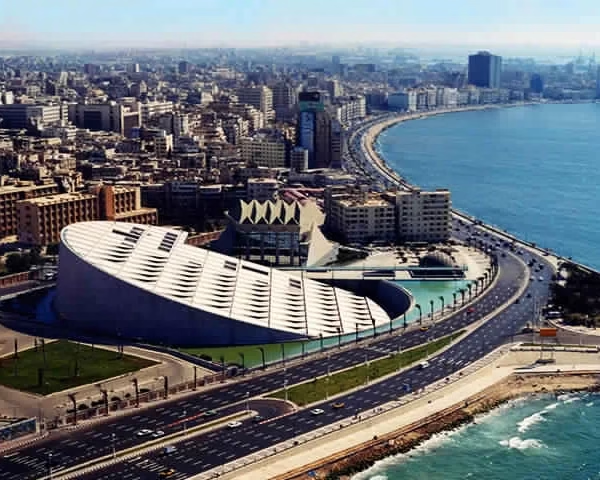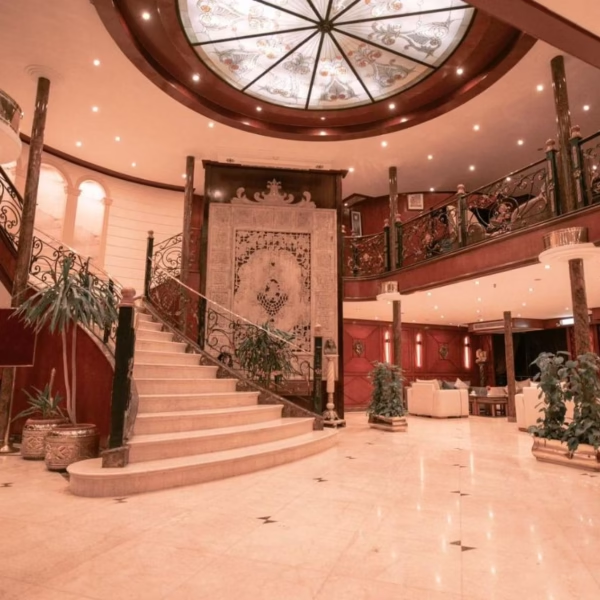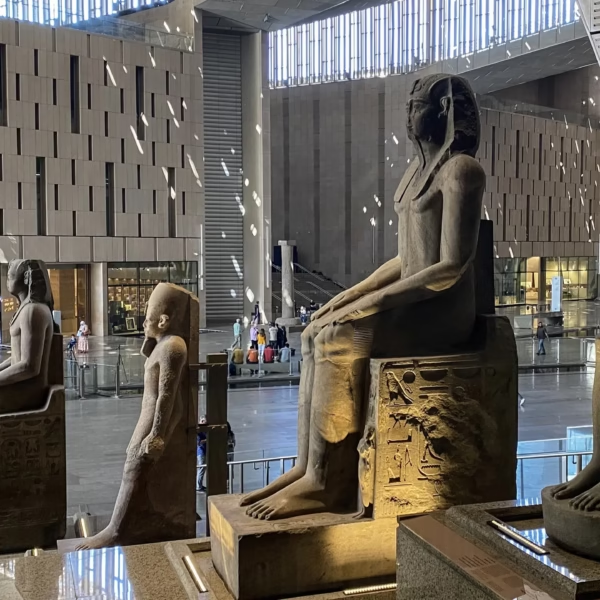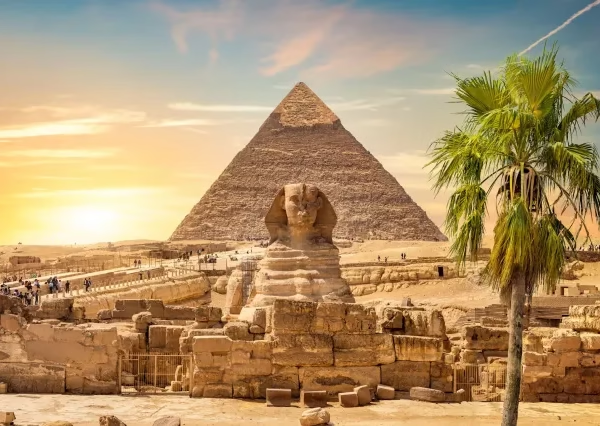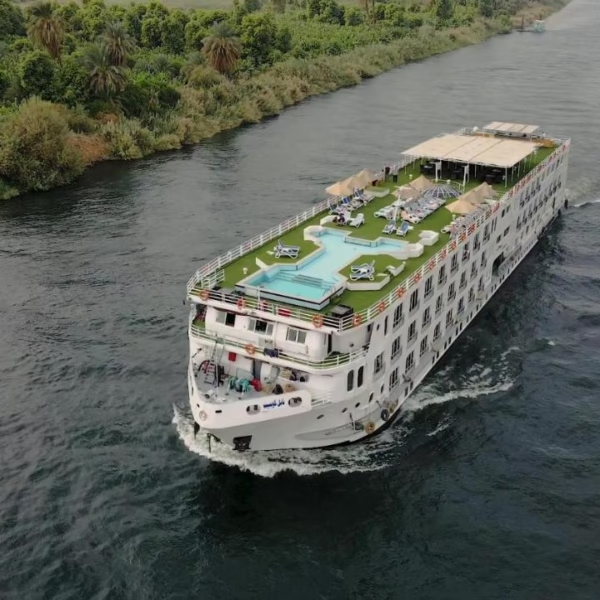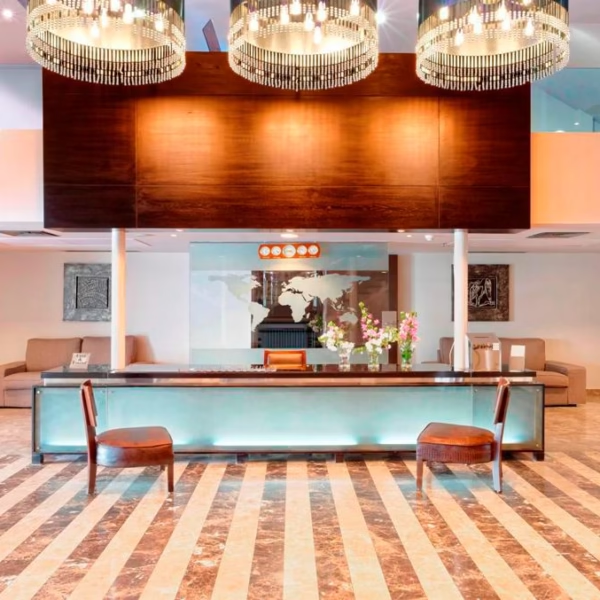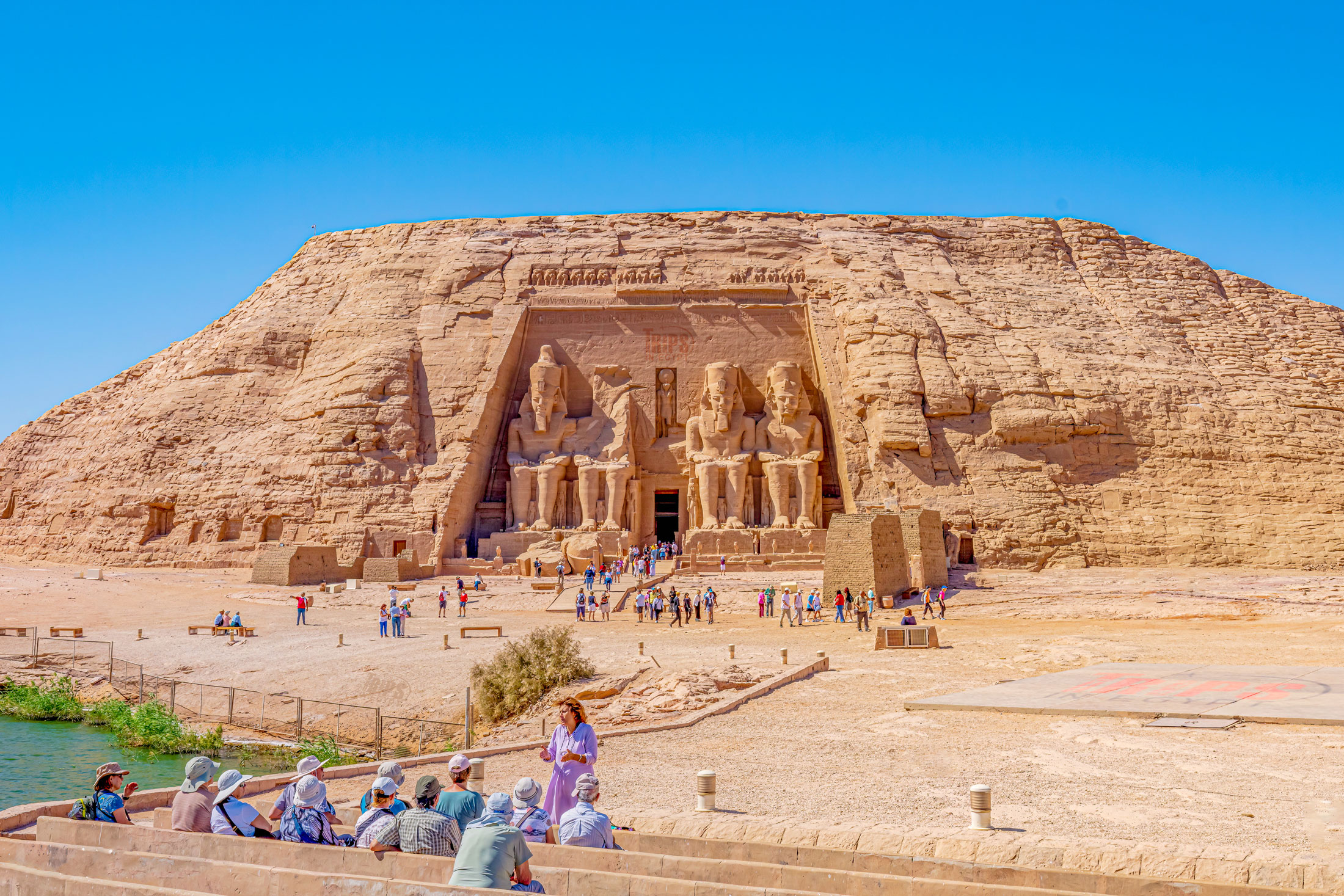Embark on an unforgettable 9-day journey through the timeless wonders of Egypt with this expertly curated tour that blends history, culture, and comfort. Guided by a professional Egyptologist and supported by top-tier services—including a private air-conditioned vehicle and handpicked accommodations—you’ll discover the enduring charm of Egypt’s most iconic destinations: Cairo, Alexandria, Luxor, and Aswan. Witness the awe-inspiring Giza Pyramids, the mysterious Saqqara Step Pyramid, and the priceless collections of the Egyptian Museum and the National Museum of Egyptian Civilization. Wander through the vibrant Khan El-Khalili Bazaar and visit spiritual landmarks like the Hanging Church. In Alexandria, explore the city’s rich Greco-Roman heritage as you visit the Qaitbay Citadel, the magnificent Alexandria Library, and the hauntingly beautiful Catacombs of Kom El Shoqafa. Then fly south to Luxor, the ancient city of Thebes, to marvel at the monumental Karnak Temple, the majestic Luxor Temple, the serene Temple of Queen Hatshepsut, and the royal tombs of the Valley of the Kings. Finally, sail to Aswan to admire the graceful Philae Temple, the impressive High Dam, and journey onward to the world-famous Abu Simbel Temples, carved into the cliffs by Ramses II himself.
10 Days Cairo, Alexandria, Luxor & Aswan Tour
Overview
Included/Exclude
- 3 Night accommodation at a 5* Hotel in Luxor. 3
- Nights accommodation at your 5* Hotel in Cairo. 2
- Night accommodation at your 5* Hotel in Aswan.
- Flight tickets (Cairo to Aswan - Luxor to Cairo). The
- service of meet and assist at all your destinations.
- Meals as included in the tour Itinerary.
- 1st class train ticket from Aswan to
- Luxor. Assist Service at Cairo Airport.
- All transfers in a modern A.C vehicle.
- Entrance fees to all the sites in the itinerary.
- An expert Egyptologist tour guide.
- All service charges and taxes.
- Egypt Entry Visa.
- International Airfare.
- Any Personal Expenses.
- Any Gratitude “Tipping”.
- Anything not mentioned in your tour itinerary
Tour Info
Tour Plan
Upon arrival at Cairo Airport, our representative will assist you with visa and luggage
procedures. You’ll then be transferred by a private A/C vehicle to your 5-star hotel for check-in
and an overnight stay in Cairo.
Dinner Time
At night-time, a dinner cruise on the enchanting Nile will be waiting for you as you will get to
relax and witness a memorable colorful belly dancing show with a folklore band featuring a
majestic Tannoura spin in keeping with Egypt's whirling dervishes tradition.
Overnight
You will head back to your hotel overnight.
Meals: Dinner Overnight: Cairo Hotel
After you have your breakfast and check out from the hotel in Cairo, you will visit the Giza
pyramids complex, where grandeur was left untouched by time. The Giza pyramids complex for
more than 4000 years acted as a reminder of the glory of the everlasting Egyptian civilization,
there you will find:
Giza Pyramids Complex
The Great Pyramid of Giza is one of the oldest and largest constructions in the
world. Built by King Khufu around 2580 BC, it marked the beginning of the
golden age of construction in ancient Egypt. The pyramid is over 4,500 years old
and was completed in just 20 years using approximately 2,300,000 blocks of
limestone. It originally stood at a height of 147 meters (481 feet), making it the
tallest man-made structure in the world for 3,800 years, until the construction of
the Lincoln Cathedral in England in 1311. The Great Pyramid remains surrounded
by mystery due to the complexity of its internal chambers compared to its massive
scale, which has inspired various theories and ongoing curiosity.
The Great Pyramid
The Great Pyramid of Khufu rises like a beacon of eternity, standing as the last
surviving wonder of the Seven Wonders of the Ancient World. Over 4,500 years
old, it remains one of the greatest architectural mysteries in history, surrounded
by countless theories due to its massive scale and intricate interior. Built around
2580 BC over a span of 20 years, it was constructed using approximately 2.3
million limestone blocks, each weighing about 2.5 tons. A workforce of 100,000
skilled laborers brought this colossal monument to life, raising it to a height of
147 meters (481 feet), making it the tallest man-made structure in the world for
nearly 3,800 years—until the Lincoln Cathedral in England surpassed it in 1311
AD. The Great Pyramid continues to captivate all who stand in its shadow, a
timeless symbol of Egypt’s genius and legacy.
The Great Sphinx
The Great Sphinx of Giza is the oldest known statue in existence and has served
as a source of inspiration for countless travelers, poets, and historians. To this
day, it remains surrounded by mystery. The statue measures 73 meters (240 feet)
in length and 19 meters (66 feet) in height. It depicts a mythical creature known
as the Sphinx, with the body of a lion and the head of a man, believed to
represent King Khafre. This form was intended to symbolize strength, wisdom,
and royal authority.
The Grand Egyptian Museum
The Grand Egyptian Museum is a monumental gateway to the extraordinary
legacy of ancient Egypt, reflecting over 5,000 years of continuous innovation,
craftsmanship, and artistic vision. This vast complex offers a rare opportunity to
explore some of the most remarkable archaeological artifacts ever discovered.
Highlights within the museum include the Hanging Obelisk, the colossal statue of
King Ramses II, the ten statues of King Senusert, the Grand Staircase, statues of
Ptolemaic kings and queens, the Victory Column of King Merneptah, the Royal
Regalia, and the expansive Grand Atrium and gift shop.
Lunch Time
After that, you will enjoy your delicious lunch meal and join your tour guide to
complete your day in Cairo by visiting:
Overnight
After that, you will head to Cairo airport to catch your flight to Aswan and check
in 5* hotel for overnight.
Meals: Breakfast, Lunch Flight: From Cairo to Aswan Overnight: Aswan Hotel
On day three, you will enjoy your breakfast at the hotel in Aswan and continue
your holiday in Egypt by exploring some of the top Aswan tourist attractions such
as:
Philae Temple
The enchanting Philae Temple is a symbol of devotion, beauty, and resilience,
nestled on Agilkia Island in the heart of the Nile near Aswan. Originally built
during the Ptolemaic period and completed by Roman emperors, the temple was
dedicated to Isis, the goddess of motherhood, healing, and magic. Its intricate
reliefs and majestic columns tell sacred stories of love, protection, and rebirth.
Philae became one of the last places where the ancient Egyptian religion was
practiced. When threatened by the rising waters of the Nile due to the
construction of the Aswan High Dam, the entire temple complex was carefully
relocated in one of the greatest rescue missions in archaeological history. Today,
Philae Temple stands as a breathtaking blend of ancient spirituality and modern
preservation, offering visitors a timeless journey into Egypt's mythical soul.
Unfinished Obelisk
The Unfinished Obelisk of Aswan offers a rare and intimate glimpse into the
craftsmanship and ambition of ancient Egyptian builders. Carved directly into the
bedrock of a granite quarry, this colossal monument was intended to be the
largest obelisk ever constructed, estimated to reach a height of 42 meters (138
feet) and weigh over 1,000 tons. However, a crack in the stone halted its
completion, leaving it forever embedded in its original resting place. The site
reveals the remarkable techniques used by ancient artisans, including the use of
dolerite tools to cut through the granite. Today, the Unfinished Obelisk stands as
a powerful testament to the skill, precision, and aspirations of a civilization that
sought to reach the heavens through stone.
Aswan High Dam
The Aswan High Dam is a modern marvel of engineering that transformed the
Nile and the future of Egypt. Completed in 1970, this massive structure was built
to control the annual flooding of the Nile, provide reliable irrigation, and
generate hydroelectric power to fuel Egypt’s development. Stretching over 3,800
meters (12,500 feet) long and standing 111 meters (364 feet) high, the dam
created Lake Nasser, one of the largest man-made lakes in the world. While the
dam brought tremendous benefits, it also led to significant changes in the
region’s ecosystem and the relocation of many ancient monuments, including the
famous temples of Abu Simbel, which were carefully moved to save them from
flooding. The Aswan High Dam symbolizes Egypt’s blend of ancient heritage and
modern progress.
Lunch Time .
Head with your tour guide to have your lunch meal before visiting:
Overnight
You will then return to your hotel overnight.
Meals: Breakfast, Lunch Overnight: Aswan Hotel
Abu Simbel Complex
The magnificent temples of Abu Simbel are enduring masterpieces of ancient
Egyptian architecture and symbolism. Built by King Ramses II between 1264 BC
and 1244 BC, the larger temple—often called the Temple of Ramesses, Beloved of
Amun—stands as a tribute to his legacy. It commemorates his victory at the
Battle of Kadesh, honors his beloved wife Queen Nefertari, and pays homage to
the gods Amun Ra, Ra-Horakhty, and Ptah. These temples continue to inspire
awe, reflecting both the power and devotion of one of Egypt’s greatest pharaohs.
Lunch Time
At the end of your day tour, transfer to Aswan to have your lunch meal.
Overnight
You will stay overnight in the Aswan Hotel.
Meals: Breakfast, Lunch Overnight: Aswan Hotel
After Breakfast You will meet our tour guide and will transfer to
Kom Ombo Temple
is a unique double temple located on the Nile River between Edfu and Aswan.
Built during the Ptolemaic period, it is dedicated to two gods: Sobek, the
crocodile god of fertility and the Nile, and Horus the Elder, the falcon-headed
god of protection. The temple’s symmetrical design features twin entrances,
halls, and sanctuaries for each deity. Kom Ombo is also known for its fascinating
carvings, including ancient surgical instruments and a small museum displaying
mummified crocodiles. A visit to Kom Ombo offers a rare look into dual worship
and daily life in ancient Egypt.
Edfu Temple,
dedicated to the falcon god Horus, is one of Egypt’s best-preserved ancient
temples. Built during the Ptolemaic period, it features towering columns, detailed
reliefs, and mythological inscriptions that tell the story of Horus’s victory over
Set. A visit to Edfu offers a vivid glimpse into ancient Egyptian religion and
architecture.
Lunch Time
At the end of your day tour, transfer to the restaurant in Luxor.
Overnight
You will stay overnight in the Luxor Hotel.
Meals: Breakfast, Lunch Overnight: Luxor Hotel
On the fifth day, you will enjoy breakfast at the hotel and continue your vacation
by exploring Luxor East Bank attractions such as:
The Karnak Complex
The Karnak Temples Complex is the second most visited site in Egypt and one of
the most awe-inspiring archaeological wonders in the world. Located in the heart
of ancient Thebes, Karnak served as a major religious center for over two
millennia, with construction spanning from the Middle Kingdom around 1971 BC
to the Ptolemaic period in 30 BC. The vast complex features some of ancient
Egypt’s most monumental architectural achievements, including the Precinct of
Amun-Re, Precinct of Mut, Precinct of Montu, the iconic Hypostyle Hall, and the
majestic Avenue of Sphinxes, each bearing witness to the grandeur and devotion
of the ancient Egyptian civilization.
Luxor Temple
The majestic Luxor Temple is a timeless masterpiece carved on the eastern bank
of the Nile in the heart of ancient Thebes. Built around 1400 BC, this sacred
temple was not dedicated to any god or pharaoh in particular but to the
rejuvenation of kingship itself—making it a unique spiritual center in ancient
Egypt. Unlike other temples, Luxor Temple was the site of the Opet Festival,
where the divine power of the pharaoh was renewed. It was expanded by some of
Egypt's most powerful rulers, including Amenhotep III, Tutankhamun,
Horemheb, and Ramses II, whose colossal statues still guard the entrance.
Illuminated at night, the temple glows with a mystical golden aura, offering
visitors an unforgettable glimpse into Egypt’s divine past and architectural
brilliance.
At the end of the day, transfer back to your hotel overnight.
Meals: Breakfast, Lunch Overnight: Luxor Hotel
After having breakfast and checking out from the hotel, you will continue your
trip in Luxor by exploring the rest of the mesmerizing Luxor tourist attractions
such as:
The Valley of The Kings
Hidden within the central core of the Theban Necropolis, the Valley of the Kings
is home to 65 rock-cut tombs belonging to the legendary pharaohs and nobles of
the New Kingdom (1570–1050 BC). These tombs form an underground labyrinth
showcasing some of the most remarkable examples of ancient Egyptian art. Their
walls are adorned with vivid scenes that reveal the civilization’s complex
historical, mythological, and religious beliefs, offering a profound glimpse into
the journey to the afterlife and the legacy of Egypt’s immortal ruler
The Mortuary Temple of Hatshepsut
often referred to as the “Holy of Holies,” is a breathtaking masterpiece of ancient
Egyptian architecture and design. Carved into the cliffs of Deir El Bahari, this
grand temple stands as a lasting tribute to Queen Hatshepsut (1473–1458 BC),
one of Egypt’s most remarkable rulers. Dedicated to the god Amun, the temple
reflects both divine devotion and the queen’s extraordinary legacy, offering
visitors a stunning vision of elegance, symmetry, and spiritual grandeur
The Colossi of Memnon
are two monumental twin statues carved in the likeness of Pharaoh Amenhotep
III, each standing at an impressive height of 18 meters (60 feet). Dating back to
around 1350 BC, these statues were originally built to guard the entrance of
Amenhotep III’s mortuary temple and serve as enduring symbols of his power,
legacy, and royal lineage. During the Greco-Roman period (20 AD to 250 AD),
the site became associated with the mythological Greek hero Memnon, and
inscriptions from that era added layers of cultural and historical significance to
these majestic figures.
Lunch Time
Have a break to enjoy your lunch meal before visiting:
Overnight
Then return to your hotel in Luxor overnight.
Meals: Breakfast, Lunch Overnight: Luxor Hotel
Day 7 will begin when you have your breakfast and check out from your hotel in
Luxor and fly straight to Cairo to complete your 9 days Egypt itinerary by visiting
some tiptop Cairo tourist attractions such as:
The Egyptian Museum
The Egyptian Museum is a timeless exhibition that houses the largest and most
significant collection of ancient Egyptian artifacts. Established in 1901 in the
heart of Cairo, it showcases the rich history and culture of Egypt through its
priceless treasures.
Lunch Time
After that you will have a break to enjoy your lunch before you complete your day
by visiting:
The Hanging Church
One of the oldest and most famous Coptic churches in Egypt, the Hanging
Church is located in Old Cairo and dates back to the 3rd century. It is uniquely
built above the gatehouse of the ancient Roman fortress of Babylon, giving it the
name "hanging." The church features stunning wooden architecture, intricate
icons, and a rich history that reflects Egypt’s deep Christian heritage.
Amr Ibn Al Aas Mosque
The Mosque of Amr ibn al-As is the first mosque built in Egypt and Africa,
established in 642 AD by the Arab general Amr ibn al-As, who led the Muslim
conquest of Egypt. Located in Old Cairo's Fustat district, it served as the nucleus
of Egypt's first Islamic capital. Although the original structure no longer exists,
the mosque has undergone numerous renovations over the centuries and remains
an active place of worship and a significant historical site.
Ben Ezra Synagogue
Located in Old Cairo, the Ben Ezra Synagogue is Egypt’s oldest Jewish temple,
dating back to the 9th century. It’s famous for the discovery of the Cairo Geniza, a
treasure trove of ancient Jewish manuscripts. Recently restored, the synagogue
showcases beautiful architectural details and reflects Egypt’s diverse religious
heritage.
The National Museum of Egyptian Civilization (NMEC),
located in Fustat within Old Cairo, is a remarkable institution showcasing over
50,000 artifacts spanning 4,000 years of Egypt’s rich culture and history. Visitors
have the unique opportunity to see royal mummies and some of the greatest
works of ancient Egyptian art displayed throughout its many rooms and galleries.
Al-Muizz Street
Al-Muizz Street is a historic treasure that has stood the test of time, showcasing
ancient Islamic history in the heart of Old Cairo. Built in the 10th century by
the
Fatimid dynasty, it became a vibrant social hub alongside the famous Khan El
Khalili Bazaar. The area was added to the UNESCO World Heritage list in 1979.
Khan El Khalili Bazaar
Located in the heart of Islamic Cairo, Khan El Khalili is Egypt’s most famous and
vibrant bazaar. Dating back to the 14th century, this historic market is filled with
winding alleys lined with shops selling spices, perfumes, jewelry, antiques,
souvenirs, and traditional crafts. It’s the perfect place to experience Cairo’s lively
atmosphere, sip mint tea at a local café, and haggle like a true local.
Overnight
You will then return to the hotel overnight.
Meals: Breakfast, Lunch Flight: From Luxor to Cairo Overnight: Cairo Hotel
On day eight, you will have your breakfast and continue your experience in Egypt
by heading to the pearl of the Mediterranean Sea to explore Alexandria's Tourist
Attractions:
Catacombs of Kom El Shoqafa
The Catacombs of Kom El Shoqafa, located in Alexandria, are one of the Seven
Wonders of the Middle Ages. Dating back to the 2nd century AD, these
underground tombs blend Pharaonic, Greek, and Roman artistic styles. The
complex includes a spiral staircase, burial chambers, and richly decorated statues
Pompey's Pillar
Pompey's Pillar is one of the most famous ancient monuments in Alexandria,
Egypt. Standing at about 26 meters (85 feet) high, it was built in 297 AD in honor
of the Roman Emperor Diocletian. Despite its name, it has no connection to the
Roman general Pompey. Made of red granite from Aswan, it is the largest Roman
triumphal column outside of Rome and still stands as a powerful symbol of
Alexandria’s Greco-Roman heritage.
Lunch Time
After having your special lunch meal at a local restaurant in Alexandria, then
move to visit:
Qaitbay Citadel
The Qaitbay Citadel is a 15th-century fortress located on the Mediterranean
coast of Alexandria, built in 1477 AD by Sultan Al-Ashraf Qaitbay. It was
constructed on the exact site of the ancient Lighthouse of Alexandria, one of the
Seven Wonders of the Ancient World. Designed to protect Egypt from naval
attacks, the citadel features impressive Islamic military architecture and offers
stunning sea views. Today, it stands as a symbol of Alexandria’s rich maritime
history.
The Alexandria Library (Bibliotheca Alexandrina)
The Bibliotheca Alexandrina is a modern revival of the ancient Library of
Alexandria, once the greatest center of learning in the ancient world. Inaugurated
in 2002, the new library is a stunning architectural masterpiece shaped like a
giant tilted disc, symbolizing the rising sun of knowledge.
Overnight
You will then return to Cairo to spend the night.
Meals: Breakfast, Lunch Overnight: Cairo Hotel
After breakfast you will transfer to Cairo Airport to fly Home
Review Scores
Related Tours
Frequently Asked Questions
What is the best time to visit Egypt?
The best time to visit Egypt is during the cooler months from October to April, when temperatures are mild and comfortable for sightseeing. Avoid the peak summer months (June to August) as it can get extremely hot, especially in desert and southern regions.
How is the summer time weather in Egypt?
Summer in Egypt (June to August) is very hot, with temperatures often exceeding 40°C (104°F), especially in desert areas and southern cities like Luxor and Aswan. Coastal areas like Alexandria and the Red Sea are a bit cooler with sea breezes.
What is the best advice to a family with kids visiting Egypt?
For families with kids visiting Egypt, it’s best to choose family-friendly tours with shorter travel times, plenty of breaks, and activities suitable for children. Stay in comfortable accommodations, keep hydrated, protect from the sun, planning ahead and pacing the itinerary will ensure a fun and safe experience for everyone.
What should a woman traveler know before going to Egypt?
For foreign women traveling to Egypt, dress modestly, avoid walking alone at night, use trusted transport, stay in well-reviewed accommodations, and be aware of local customs to ensure a safe and comfortable trip.
Booking Tour
Last Minute Deals




